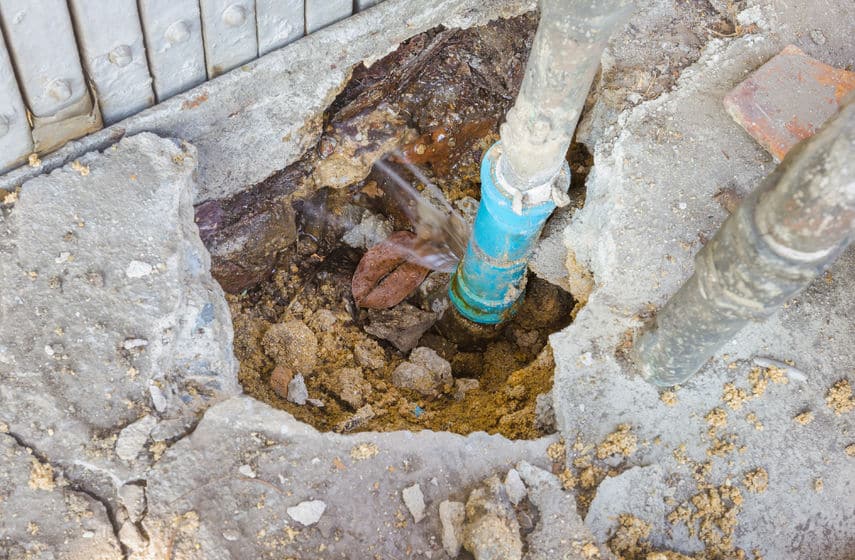
As a homeowner, one of your main priorities is to keep your home running in top shape, which means you’ve likely dealt with your fair share of home improvement issues. While some jobs may be easier to identify and tackle–such as lawn care or keeping your space clean–some home repair issues can sneak up on you when you least expect it. The perfect example of this unfortunate situation?
A plumbing leak.
Plumbing leaks aren’t always as obvious as a puddle of water waiting for you when you get home, although that’s certainly one way to find a leak. Unfortunately, there are times when more extensive leak detection measures are necessary. If you’re suspicious that your home may have a plumbing leak, or if you want a routine check to rule out the possibility, RJ Tilley can help.
Below, you’ll find proven methods for plumbing leak detection that have our expert stamp of approval.
Visual Clues That Reveal a Plumbing Leak
The plumbing in your home is a complex system. Leaks can occur both above and below your foundation in pipes, in drains, and in the service main that connects your water meter to your home. The simplest way to check for plumbing leaks in your home is to keep your eyes, ears, and nose open for the warning signs.
Leak Detection Above the Slab
Leaks that occur above the concrete foundation of your home, or above the slab, will give a good indication of their source with physical clues. If you notice any of the following, you should pick up the phone and call a plumbing technician:
- Visible water – Whether it’s a puddle in your kitchen or carpet that’s soaked through, when you have visible water, you likely have a plumbing leak.
- Discoloration on a wall or baseboard – Is a brown or yellowish patch starting to grow on the wall by your bathroom sink? It doesn’t mean your bathroom needs a good scrub. It means you have a leak!
- Damage to flooring – If your wood floor is warping or your linoleum floor is peeling, the cause could be a plumbing leak. It’s time to call in the experts!
While these visible signs indicate the general vicinity of the leak, if the exact source is behind a wall or covered up by cabinets, a little extra digging will be necessary. Whenever you reach the end of your comfort level with home improvement tasks, your next step should always be to call an expert. One wrong move could end up causing more damage to your home and costing you more money. This is especially true when the leak is in a more complicated place, such as a drain or the service main.
Drain Leaks
Let’s be honest: Drains are one of the most germ-infested areas of your home. They catch the dirty water from your kitchen, bathroom sinks, showers, and toilets. But, that doesn’t mean they should smell badly. A lingering, unpleasant odor around your drain is a sign that you may have a leak. If that odor is accompanied by the presence of insects–especially small flies or gnats–then a leak is even more likely. Of course, visible water pooling under or around your drains is also a strong sign that you have a plumbing issue.
Service Main Leaks
The pipe, or service line, that connects the water meter to your home is located fairly deep in the ground; that means the pipe is covered by some combination of grass, concrete, or paving. If you walk outside one morning and discover a wet, spongy lawn, a leak in the service main is most likely the culprit. Additionally, if you keep coming across water that appears to be seeping from any cracks in the walkways around your home, you may have a plumbing leak.
Leak Detection Below the Slab
If you have a plumbing leak below the concrete foundation of your home, leak detection becomes a little trickier. In fact, the signs you’ll need to watch out for aren’t necessarily visual:
- Water running in your pipes – If you constantly hear the sound of water running, it isn’t normal. Have an expert check for a leak below the slab.
- Low water temperature – Does the water in your home simply not get hot anymore? Or, does the water temperature cool down quickly? A leak below your foundation could be the cause.
The Water Meter Tells All
It may sound simple, but one way to check for plumbing leaks is to pay attention to the water meter levels reported on your monthly water bill. If there is a drastic increase in water usage, you have probably also noticed an increase in your bill. While a small leak above the slab may not cause this, a serious leak below the slab can be revealed by your water bill.
Plumbing Leak Detection with Pressure Tests
If the visual clues aren’t confirming your suspicions, and your water bill hasn’t changed drastically over the last few months, you may need a more in-depth leak detection test that is best performed by a plumbing technician. A hydrostatic pressure test can check for leaks throughout your home’s entire plumbing system.
To conduct this leak detection test, an inflatable ball will be inserted into the service line to block the main line coming in and out of your home. The ball will be inflated, and the sewer system will be filled with water up to the slab. An expert will observe the water level, taking note if the system doesn’t fill up all the way or if the water level drops. If either occurs, one or more leaks are present. The next step is to find the source of the leaks, potentially with further testing.
When in Doubt, Call An Experienced Plumber
Again, you should only perform home improvement tasks you feel comfortable doing. If you think you have a plumbing leak, but you aren’t confident in your ability to assess the situation, contact a plumbing technician. Or, if you’ve found the source of the leak, but you’re unsure of the steps you should take to fix it, call for backup. Our experts are happy to help!
Contact R.J. Tilley today to get leak detection services from our plumbing experts.








